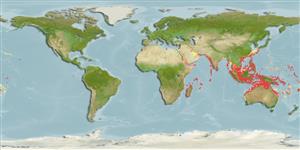Common names from other countries
>
Eupercaria/misc (Various families in series Eupercaria) >
Lethrinidae (Emperors or scavengers) > Lethrininae
Etymology: Lethrinus: Greek, lethrinia, a fish pertaining to genus Pagellus.
More on author: Lacepède.
Issue
Junior synonym L. punctulatus is a junior synonym od Lethrinus laticaudis according to Larson et al., 2013:141 (Ref. 94170).
Environment: milieu / climate zone / depth range / distribution range
Sinh thái học
Biển; Thuộc về nước lợ Cùng sống ở rạn san hô; không di cư; Mức độ sâu 10 - 90 m (Ref. 6390). Tropical; 32°N - 35°S, 24°E - 167°W
Indo-West Pacific: widespread, from the Red Sea, Arabian (Persian) Gulf, and East Africa to the Ryukyus and Tonga.
Length at first maturity / Bộ gần gũi / Khối lượng (Trọng lượng) / Age
Maturity: Lm 24.1, range 18 - ? cm
Max length : 52.0 cm TL con đực/không giới tính; (Ref. 1020); common length : 40.0 cm TL con đực/không giới tính; (Ref. 5450); Tuổi cực đại được báo cáo: 19 các năm (Ref. 42001)
Các tia vây lưng cứng (tổng cộng) : 10; Các vây lưng mềm (tổng cộng) : 9; Tia cứng vây hậu môn: 3; Tia mềm vây hậu môn: 8. This species is distinguished by the following characters: body moderately deep, its depth 2.5-2.8 times in standard length; head length 0.9-1 times in body depth, 2.6-3 times in SL, dorsal profile near eye nearly straight; snout moderately short, its length about 1.9-2.4 times in HL, measured without the lip the snout is 0.8-1 times in cheek height, its dorsal profile nearly straight, snout angle relative to upper jaw between 60° and 70°; interorbital space convex; posterior nostril an oblong longitudinal opening, closer to orbit than anterior nostril; eye situated close to or far removed from dorsal profile, its length 3.3-4.8 times in HL; cheek not high, its height 2.4-3.1 times in HL; lateral teeth in jaws rounded often with conical tips, or molars often with tubercles; outer surface of maxilla with a longitudinal ridge; D X,9 with the 4th dorsal-fin spine usually the longest, its length 2.4-3.4 times in body depth; A III,8 soft rays, the first soft ray usually the longest, its length almost equal to or shorter than length of base of soft-rayed portion of anal fin and 1-1.2 times in length of entire anal-fin base; pectoral-fin rays 13; pelvic-fin membranes between rays closest to body without dense melanophores; cheek without scales; 46-47 lateral-line scales usually; 5 ½ scale rows between lateral line and base of middle dorsal-fin spines; 15- 16 scale rows in transverse series between origin of anal fin and lateral line; usually 15 rows in lower series of scales around caudal peduncle; 4-9 scales in supratemporal patch; inner surface of pectoral-fin base densely covered with scales, with a few scales, or naked; posterior angle of operculum fully scaly. Colour of body greenish or grey, shading to white below, centers of scales on upper sides often white; posterior margin of opercle and sometimes base of pectoral fins red; pectoral fins white, yellow, or pinkish; pelvic and anal fins white to orange; dorsal fin white and orange mottled with a reddish margin; caudal fin mottled orange or reddish (Ref. 114226).
Inhabits sandy bottoms in coastal areas, deep lagoons and near coral reefs (Ref. 30573). Juveniles and small adults commonly in loose aggregations over seagrass beds, mangrove swamps and shallow sandy areas while adults are generally solitary in deeper waters. Feeds primarily on crustaceans and mollusks but echinoderms, polychaetes and fishes are also consumed in considerable quantities (Ref. 2295). A protogynous hermaphrodite (Ref. 55367). Caught primarily by handline, traps, trawls, beach seines, and gill nets. Marketed mostly fresh (Ref. 68703).
A monandric species (Ref. 55367). Length at sex change = 30.8 cm TL (Ref. 55367). Also Ref. 103751.
Carpenter, K.E. and G.R. Allen, 1989. FAO Species Catalogue. Vol. 9. Emperor fishes and large-eye breams of the world (family Lethrinidae). An annotated and illustrated catalogue of lethrinid species known to date. FAO Fish. Synop. 125(9):118 p. Rome: FAO. (Ref. 2295)
IUCN Red List Status (Ref. 130435)
CITES (Ref. 128078)
Not Evaluated
Threat to humans
Harmless
Human uses
Các nghề cá: tính thương mại cao
Các công cụ
Special reports
Download XML
Các nguồn internet
Estimates based on models
Preferred temperature (Ref.
115969): 24.6 - 29, mean 28 (based on 1436 cells).
Phylogenetic diversity index (Ref.
82804): PD
50 = 0.5000 [Uniqueness, from 0.5 = low to 2.0 = high].
Bayesian length-weight: a=0.01514 (0.01267 - 0.01808), b=2.97 (2.93 - 3.01), in cm Total Length, based on LWR estimates for this species (Ref.
93245).
Mức dinh dưỡng (Ref.
69278): 3.9 ±0.2 se; based on diet studies.
Thích nghi nhanh (Ref.
120179): Trung bình, thời gian nhân đôi của chủng quần tối thiểu là 1.4 - 4.4 năm (K=0.17-0.27; tm=2-3.8; tmax=15).
Prior r = 0.73, 95% CL = 0.48 - 1.10, Based on 3 data-limited stock assessments.
Fishing Vulnerability (Ref.
59153): Low vulnerability (23 of 100).
Climate Vulnerability (Ref.
125649): High to very high vulnerability (75 of 100).
